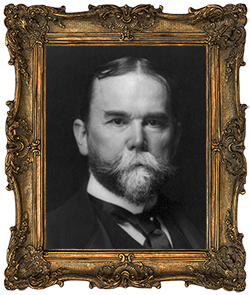The John Hay Center Celebrates 50 Years
The Washington County Historical Society celebrated their 50th anniversary of the John Hay Center on June 27th, 2021!
 Pictured: Alice Stout Williams and Charlotte Stout Hooker, (daughters of Warda Stevens Stout), join JHC Project Chairman, Coach Everett Dean, admiring the placement of the new plaque, in June 1971The herculean efforts to plan, fund, and construct a repository, to safeguard the significant materials, and to properly display the collection of county heritage, (belonging to the historical society), was a dream 74 years in the making.
Pictured: Alice Stout Williams and Charlotte Stout Hooker, (daughters of Warda Stevens Stout), join JHC Project Chairman, Coach Everett Dean, admiring the placement of the new plaque, in June 1971The herculean efforts to plan, fund, and construct a repository, to safeguard the significant materials, and to properly display the collection of county heritage, (belonging to the historical society), was a dream 74 years in the making.
A dream helped to ultimate realization by a very generous benefactor, the members and officers of the historical society, the entire Washington County community and it’s outside connections. However, shepherding the aspirations and maintaining the consistent heartbeat of the operations, was Project Manager, legendary coach and county native, Everett S. Dean.
The Work of Mr. and Mrs. Everett S. Dean
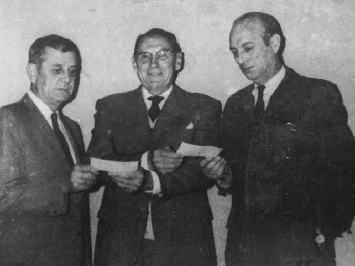 Pictured: John Hay Center Project Chairman Everett Dean, receiving two check donations from Frank Newkirk & Bill Goen, publishers of The County PressAfter retiring from his esteemed coaching career, and returning to their native county, both Everett and his wife, Lena Graves, immediately recognized the significance of establishing a community history museum and completely devoted themselves to realizing the ambitious aspirations of the historical society, to open the John Hay Center. They accepted the positions of Co-Chairman of the John Hay Center Project and determined themselves to providing a lasting legacy of contributing a local heritage center; dedicated to imparting the county’s ancestral past to educate and bolster historical pride in the county’s future generations.
Pictured: John Hay Center Project Chairman Everett Dean, receiving two check donations from Frank Newkirk & Bill Goen, publishers of The County PressAfter retiring from his esteemed coaching career, and returning to their native county, both Everett and his wife, Lena Graves, immediately recognized the significance of establishing a community history museum and completely devoted themselves to realizing the ambitious aspirations of the historical society, to open the John Hay Center. They accepted the positions of Co-Chairman of the John Hay Center Project and determined themselves to providing a lasting legacy of contributing a local heritage center; dedicated to imparting the county’s ancestral past to educate and bolster historical pride in the county’s future generations.
Scanning through the historical society’s minutes and scrapbooks of the years leading up to the center’s opening, along with the literally thousands of personal letters and correspondence, left here from the Everett Dean estate; it is blatantly obvious that for whatever recognition he may have received at the time, his true efforts remain largely untold and uncelebrated.
The Deans were the tireless twosome, who hardly left a stone unturned in each and every aspect of every phase of the project. They maintained everyone’s interest and enthusiasm in the enterprise for years, including ensuring the security of our most significant benefactor, Warda Stevens Stout. Cultivating a real relationship, through regular communications, project updates, consultation meetings, personal visits, and consistently keeping Mrs. Stout involved. The couple’s genuine character won over the whole Stout family, during the process of completing the center, and garnered their support as well.
A Special Offer from Warda Stevens Stout
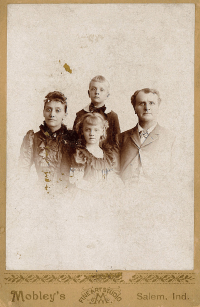 Warder & Alice (Caspar) Stevens, and their children, Warda and Ray, 1890.In the late 1960s, when Warda Stevens Stout, daughter of Warder and Alice (Caspar) Stevens, travelled from Memphis, Tennessee, to meet with the officers of the historical society, she presented a earth-shaking offer to motivate the museum fundraising campaign, with the stipulation that the building be named in honor of her parents. The extraordinarily generous proposal was that she would match every fundraising contribution the historical society received, dollar for dollar.
Warder & Alice (Caspar) Stevens, and their children, Warda and Ray, 1890.In the late 1960s, when Warda Stevens Stout, daughter of Warder and Alice (Caspar) Stevens, travelled from Memphis, Tennessee, to meet with the officers of the historical society, she presented a earth-shaking offer to motivate the museum fundraising campaign, with the stipulation that the building be named in honor of her parents. The extraordinarily generous proposal was that she would match every fundraising contribution the historical society received, dollar for dollar.
The officers, long-time members, and local history enthusiasts, sprang into action on the fundraising campaign, and from February, 1967 to July, 1969, the resolved group managed to reach just over the astounding $100,000 goal. Please realize, in today’s market that figure equates to raising $724,000.
Current knowledge within the society claims there was a one-hundred thousand dollar cap to Mrs. Stout’s generosity. However, due to her deep passion for the project, her desire to leave this legacy, to her parents, in her hometown, and the culmination of the relationships she formed here, during the undertaking, that heartened her into donating more than one-hundred thousand dollars towards the project. Her overwhelming benevolence paid for more than half of the overall project of establishing the center. Hence, the Stevens Memorial Museum at the John Hay Center.
Unquestionably, she was the most consequential or significant person involved in the undertaking, with the financial clout to motivate the dream into a realization. Undeniably the statement is true, the actual depths of Mrs. Stout’s generosity during the project, and after through her estate, are unknown to nearly everyone in the organization, but undoubtedly significant is the right word.
At the same time, it could be argued that the most meaningful person involved was the old ball coach, Everett Dean. He studied and investigated the museum game, he formulated the game plan, rallied, motivated, and inspired his team, and oversaw the execution, all the way, to opening day.
Grand Opening Ceremonies for the Stevens Museum
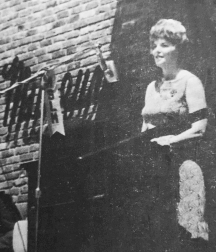 Washington County Historical Society President, Clara Marie Burns. Grand Opening ceremonies were held on June 27, 1971. At that time, the center only consisted of the Stevens Museum (an abbreviated version) and the John Hay Birthplace. Between four and five hundred people filled the new facility grounds, for the dedication ceremony, in temperatures exceeding 100 degrees. Tents with seating adorned the main driveway and a podium was placed upon the front porch for the speakers.
Washington County Historical Society President, Clara Marie Burns. Grand Opening ceremonies were held on June 27, 1971. At that time, the center only consisted of the Stevens Museum (an abbreviated version) and the John Hay Birthplace. Between four and five hundred people filled the new facility grounds, for the dedication ceremony, in temperatures exceeding 100 degrees. Tents with seating adorned the main driveway and a podium was placed upon the front porch for the speakers.
Project Chairman Dean was the first to greet the anxious crowd by saying: “We wish to extend a warm welcome from our hearts and an even warmer welcome from the sun!” After a brief introduction and synopsis of the project, he relented the podium to Washington County Historical Society President, Clara Marie Burns. During the enterprise, Clara Marie had not only proven to be an adequate leader for the organization’s transition, from the courthouse basement to the newly constructed museum, but also as one of the most diligent and passionate workers for the JHC cause.
She welcomed everyone to what she said was “the most important day in the existence of the Washington County Historical Society.” She commented how they at first had a dream, which then turned into a fantasy that was brought into reality, largely through the financial aid of their “fairy godmother, Warda Stevens Stout.” Indicating how her overwhelming generosity had far exceeded the organization’s dreams. In conclusion, Clara Marie, optimistically forecasted,
“Now the society will be able to preserve our community heritage forever.”
Salem Mayor Ralph Mahuron, expressed his great pride in the efforts put forth by the community to help complete the project and offered his felicitation for the enterprise. Representatives of the local DAR and SAR were on hand and Frank Neal’s ‘Spirit of 76 Band’ kept the program lively and entertaining.
Although Mrs. Stout was unable to attend the ceremonies, due to illness, both of her daughters came as her representation, and delivered a personal message from her. In which, she expressed her sincere gratitude for everyone who contributed so liberally to see the project to it’s completion, particularly Mr. & Mrs. Everett Dean. She declared what a great source of pride it was for her, and her family, to have a part of the Hay Center named in honor of her parents. In conclusion she wrote: “The ultimate success of this museum depends entirely on the interest you citizens take in in its future and the purpose to which it is used. Lets each one, glorify our predecessors in the fitting manner which they rightfully deserve.”
The featured speaker of the day was Salem native, Dr. James Huffman, a professor at the General Motors Institute, in Flint, Michigan. Dr. Huffman delivered a detailed biography of the center’s namesake, John Milton Hay, and wrapped up saying: “By the dedication of this center, the sons and daughters of Washington County have given testimony that they will not forget their heritage.” Inciting a rousing round of applause from those in attendance.
Current Hay Center authority, and long-time, treasured, historical society president, Willie Harlen, recollected the following about the day: “It was a beautiful day on June 27, 1971, when the John Hay Center was dedicated.
I felt very honored to be one of the guides. Since I was a local business man I knew most of the people attending the dedication. Our group stood outside the entrance to the basement. We could see the porch and ceremony. Our local S.A.R. President, David Branaman, was one of the presenters. I was a Charter member of the John Hay Chapter S.A.R.
After the ceremony was over, I stood by the large glass display case in the main gallery. It was a happy day for all to finally have the museum of our dreams.”
The venerated Coach Dean concluded the ceremonies, by sharing his hopes that the community would continue to have great pride, interest, and good-will for the John Hay Center, and then welcomed everyone into the air-conditioned museum to see all of the historic displays. Overall, the day was a smashing success for the organization, the center was labeled a uniquely fine specimen and example of Southern Indiana history.
Everett Dean’s Passion and Enthusiasm Continues
As many long-time members already know, Everett Dean’s passion and enthusiasm for the Hay Center didn’t stop after the opening. In the late 1970s and into the beginning of the 1980s, Mr. and Mrs. Dean would again helm the efforts to construct the Pioneer Village, underscoring our county’s pioneer history with authentic structures from our county’s past, re-established on the grounds behind the Hay House. Literally enabling today’s generations to walk through the bygone lives of their ancestors.
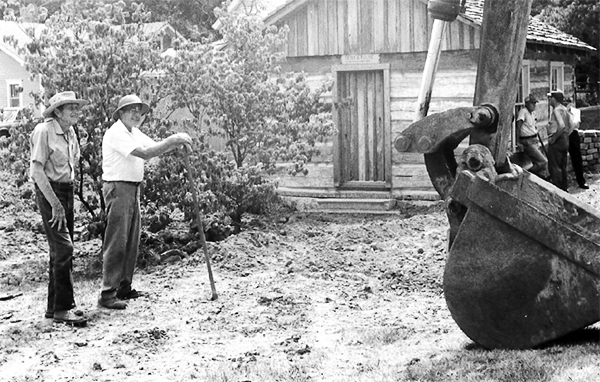 Pictured Above: Coach Dean and Roy Robertson oversee efforts to construct the Pioneer Village. (The JHC, Circa 1979)
Pictured Above: Coach Dean and Roy Robertson oversee efforts to construct the Pioneer Village. (The JHC, Circa 1979)
Everett and Lena remained fixtures at the center, up until their dying days, always maintaining an upbeat energy and a positive outlook on the future. Everyone currently involved at the John Hay Center: directors, staff, society members, and customers, are eternally grateful for the Deans and Warda Stevens Stout, for providing us with a notable historic institution, both remarkable and exceptional for any small town, anywhere in the world; as we have been repeatedly told, year after year, since 1971.
Later, the future of the John Hay Center continued to expand, as more property was acquired, two additions were made to the museum, and both the agricultural barn and The Depot were added to the center, increasing its already impressive example, and further enhancing one of the few tourist attractions in the county.
Despite the organization’s current financial struggles to correct long-standing deferred maintenance issues, we intend to celebrate this momentous occasion to the best of our abilities, and sincerely hope the current circumstances will improve enough for a celebratory affair. One to be enjoyed by our membership and the whole community. One befitting our predecessors, who established the center for the sole purpose of safe-guarding and perpetuating the county’s Hoosier heritage story.
Aspirations for the Future of the John Hay Center
It is among the many aspirations, of the current directors, to someday find the funding to erect a statue of Everett Dean, in the Pioneer Village, welcoming everyone into the legacy he helped deliver to his native community. Ensuring his benevolent contributions and likeness live freshly on the minds of our visitors for years to come.
In the meantime, everyone now involved in the representation of the center, is fully committed to scrape, scratch, beg, and fight for its survival. For the benefit of the community, and for the preservation of every family story in the history of the county’s heritage; to safe-guard and share with their future generations. And to reinstall those original Dean core principles, both within our organization and throughout the Hay Center. Furthermore, it is our pledge and greatest aspiration, to continue attempting to reestablish the center to it’s opening luster; while upgrading and enhancing it for the future, and pursuing a greater overall welfare to the members and community we serve.
Our ultimate goal is to hand off a restored treasure to the Washington County Historical Society’s next generation of members.
We deeply appreciate each member and each family’s on-going support, patronage, contributions, and sincere commitment to preserving the heritage of our Washington County ancestors, for the purpose of the enlightenment of subsequent generations.
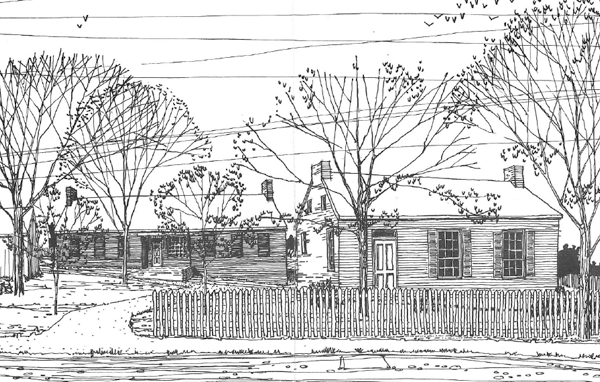 Pictured Above: Original 1969 artist depiction of the John Hay Center, in Salem, Indiana, with the John Hay Birthplace and the Stevens Memorial Museum featured.
Pictured Above: Original 1969 artist depiction of the John Hay Center, in Salem, Indiana, with the John Hay Birthplace and the Stevens Memorial Museum featured.
To paraphrase John Hay’s great mentor: “Let us resolve to keep faith with the memory of the men and women who had such great faith in us as a nation. If we but do that, this nation, under God, will have a new birth of freedom. If we do that, we shall not perish from this earth.”
Click here to download a Print Friendly Version of this Article


